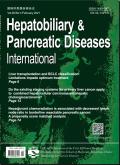大胰腺放射性结石的治疗。
IF 4.4
3区 医学
Q2 GASTROENTEROLOGY & HEPATOLOGY
Hepatobiliary & Pancreatic Diseases International
Pub Date : 2025-05-24
DOI:10.1016/j.hbpd.2025.05.003
引用次数: 0
摘要
背景:先前的研究尚未明确胰腺大放射性结石(≥5mm)的治疗方法。本研究的主要目的是评估慢性胰腺炎伴大放射性结石患者的临床特征和治疗效果,并提出治疗策略。方法:分析2011年3月至2018年6月胰管结石(≥5mm)患者的资料。结石透光组为透光组,同时出现胰腺不透光组按1:2的比例随机选择为对照组。检索人口统计学、病程和治疗细节数据,比较两组随访期间结石清除和疼痛缓解情况。结果:共纳入52例大透光性结石和104例大透光性结石。胰腺体外冲击波碎石术(ESWL)是治疗大型不透射线结石的首选方法。内镜逆行胆管造影(ERCP)是所有放射性结石组患者的第一步治疗,其中1例患者在ERCP插管失败后接受药物治疗,4例结石取出失败的患者在放置鼻胰导管后进行ESWL治疗。两组结石完全清除率无显著差异(75.0% vs 78.8%;P = 0.553)。大透光结石组51例患者随访5.8年(范围2.1-12.6),有42例(82.4%)患者疼痛完全缓解,与不透光结石组(82.4 vs 76.4%;P = 0.409)。结论:ERCP是一种有效的治疗大放射性结石的方法,应考虑作为第一步治疗。当ERCP期间结石取出失败时,建议在放置鼻胰导管后进行ESWL。本文章由计算机程序翻译,如有差异,请以英文原文为准。
Treatment of large pancreatic radiolucent stone
Background
Previous studies have not clarified the treatment of large pancreatic radiolucent stones (≥ 5 mm). The primary objective of this study was to assess the clinical features and therapeutic efficacy in patients with chronic pancreatitis who have large radiolucent stones, and to propose a treatment strategy.
Methods
This analysis examined the data of patients with large pancreatic ductal stones (≥ 5 mm) from March 2011 to June 2018. Patients with radiolucent stones were classified as the radiolucent stones group, while those with pancreatic radiopaque stones presented at the same time were randomly selected as controls in a 1:2 ratio. Data on demographics, disease courses and treatment details were retrieved, and stone clearance and pain relief during the follow-up were compared between the two groups.
Results
A total of 52 patients with large radiolucent stones and 104 patients with large radiopaque stones were included in the study. Pancreatic extracorporeal shock wave lithotripsy (ESWL) was the initial treatment for large radiopaque stone. Endoscopic retrograde cholangiopancreatography (ERCP) was the first-step treatment for all patients in the radiolucent stones group, of which one patient received medication after failed ERCP cannulation, and four who failed stone extraction were treated with ESWL following the placement of a nasopancreatic catheter. There was no significant difference in the complete stone clearance rate (75.0% vs. 78.8%; P = 0.553) between the two groups. Among the 51 patients in the large radiolucent stones group who were followed up for 5.8 years (range 2.1-12.6), complete pain relief was achieved in 42 patients (82.4%), with no significant difference compared with the radiopaque group (82.4% vs. 76.4%; P = 0.409).
Conclusions
ERCP is an effective endotherapy for large radiolucent stone and should be considered the first-step treatment. When stone extraction failed during ERCP, ESWL is recommended following the placement of a nasopancreatic catheter.
求助全文
通过发布文献求助,成功后即可免费获取论文全文。
去求助
来源期刊
CiteScore
5.40
自引率
6.10%
发文量
152
审稿时长
3.0 months
期刊介绍:
Hepatobiliary & Pancreatic Diseases International (HBPD INT) (ISSN 1499-3872 / CN 33-1391/R) a bimonthly journal published by First Affiliated Hospital, Zhejiang University School of Medicine, China. It publishes peer-reviewed original papers, reviews and editorials concerned with clinical practice and research in the fields of hepatobiliary and pancreatic diseases. Papers cover the medical, surgical, radiological, pathological, biochemical, physiological and historical aspects of the subject areas under the headings Liver, Biliary, Pancreas, Transplantation, Research, Special Reports, Editorials, Review Articles, Brief Communications, Clinical Summary, Clinical Images and Case Reports. It also deals with the basic sciences and experimental work. The journal is abstracted and indexed in SCI-E, IM/MEDLINE, EMBASE/EM, CA, Scopus, ScienceDirect, etc.

 求助内容:
求助内容: 应助结果提醒方式:
应助结果提醒方式:


